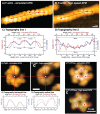Simulation atomic force microscopy for atomic reconstruction of biomolecular structures from resolution-limited experimental images
- PMID: 35294442
- PMCID: PMC8959186
- DOI: 10.1371/journal.pcbi.1009970
Simulation atomic force microscopy for atomic reconstruction of biomolecular structures from resolution-limited experimental images
Abstract
Atomic force microscopy (AFM) can visualize the dynamics of single biomolecules under near-physiological conditions. However, the scanning tip probes only the molecular surface with limited resolution, missing details required to fully deduce functional mechanisms from imaging alone. To overcome such drawbacks, we developed a computational framework to reconstruct 3D atomistic structures from AFM surface scans, employing simulation AFM and automatized fitting to experimental images. We provide applications to AFM images ranging from single molecular machines, protein filaments, to large-scale assemblies of 2D protein lattices, and demonstrate how the obtained full atomistic information advances the molecular understanding beyond the original topographic AFM image. We show that simulation AFM further allows for quantitative molecular feature assignment within measured AFM topographies. Implementation of the developed methods into the versatile interactive interface of the BioAFMviewer software, freely available at www.bioafmviewer.com, presents the opportunity for the broad Bio-AFM community to employ the enormous amount of existing structural and modeling data to facilitate the interpretation of resolution-limited AFM images.
Conflict of interest statement
The authors have declared that no competing interests exist.
Figures





References
Publication types
MeSH terms
Substances
LinkOut - more resources
Full Text Sources
Miscellaneous

